ENGR8762 - Email Acceptable Use Policy: Annotated Bibliography
VerifiedAdded on 2023/06/04
|7
|1719
|114
Annotated Bibliography
AI Summary
This annotated bibliography examines four research articles related to email acceptable use policies within organizations. It covers the definition, importance, and implementation of such policies to protect organizations from liabilities and ensure efficient operations. The articles emphasize employee education, policy enforcement, and the role of archiving in managing email communications. The bibliography highlights the consensus among the articles regarding the benefits and necessity of email acceptable use policies in today's cybersecurity landscape. Desklib provides access to this and other student-contributed assignments.
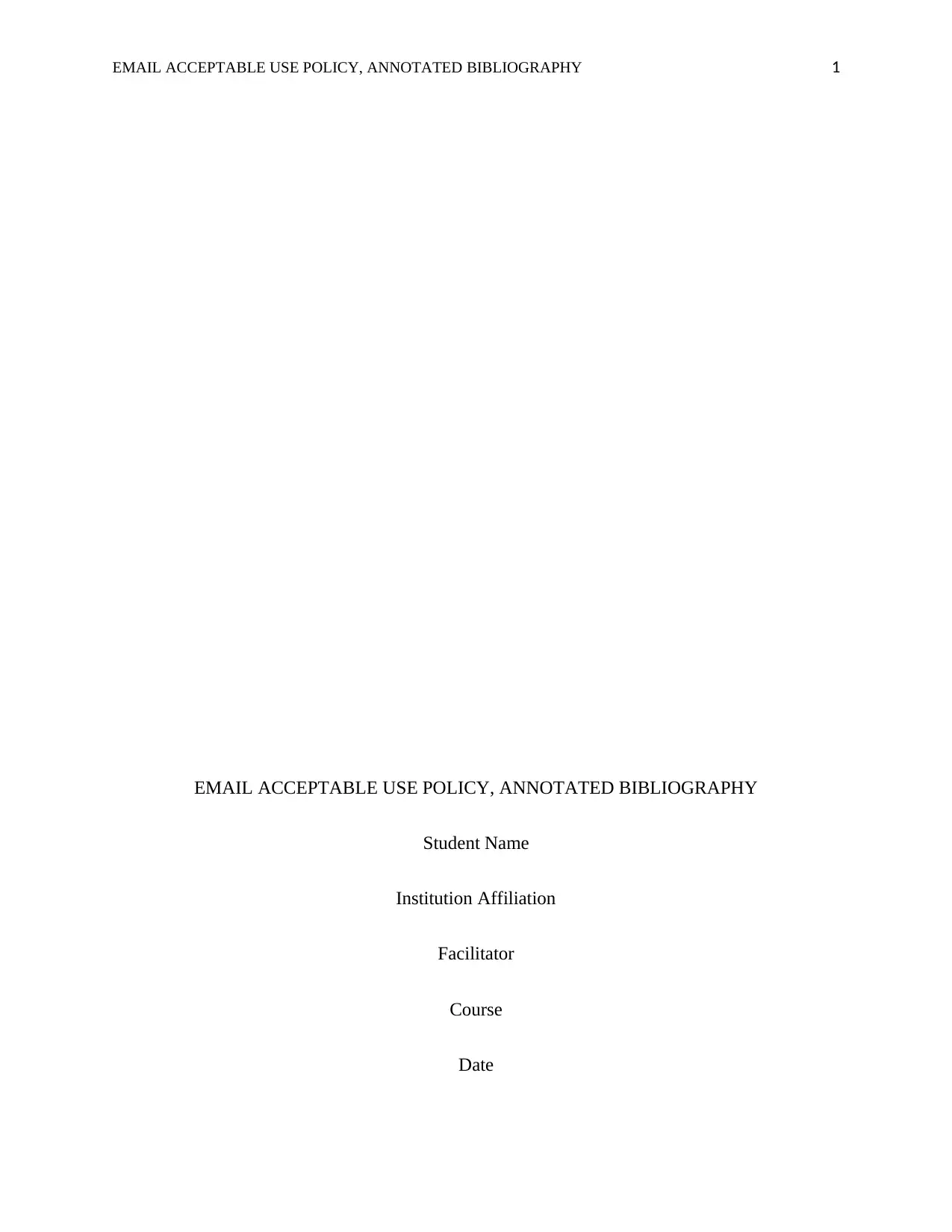
EMAIL ACCEPTABLE USE POLICY, ANNOTATED BIBLIOGRAPHY 1
EMAIL ACCEPTABLE USE POLICY, ANNOTATED BIBLIOGRAPHY
Student Name
Institution Affiliation
Facilitator
Course
Date
EMAIL ACCEPTABLE USE POLICY, ANNOTATED BIBLIOGRAPHY
Student Name
Institution Affiliation
Facilitator
Course
Date
Paraphrase This Document
Need a fresh take? Get an instant paraphrase of this document with our AI Paraphraser
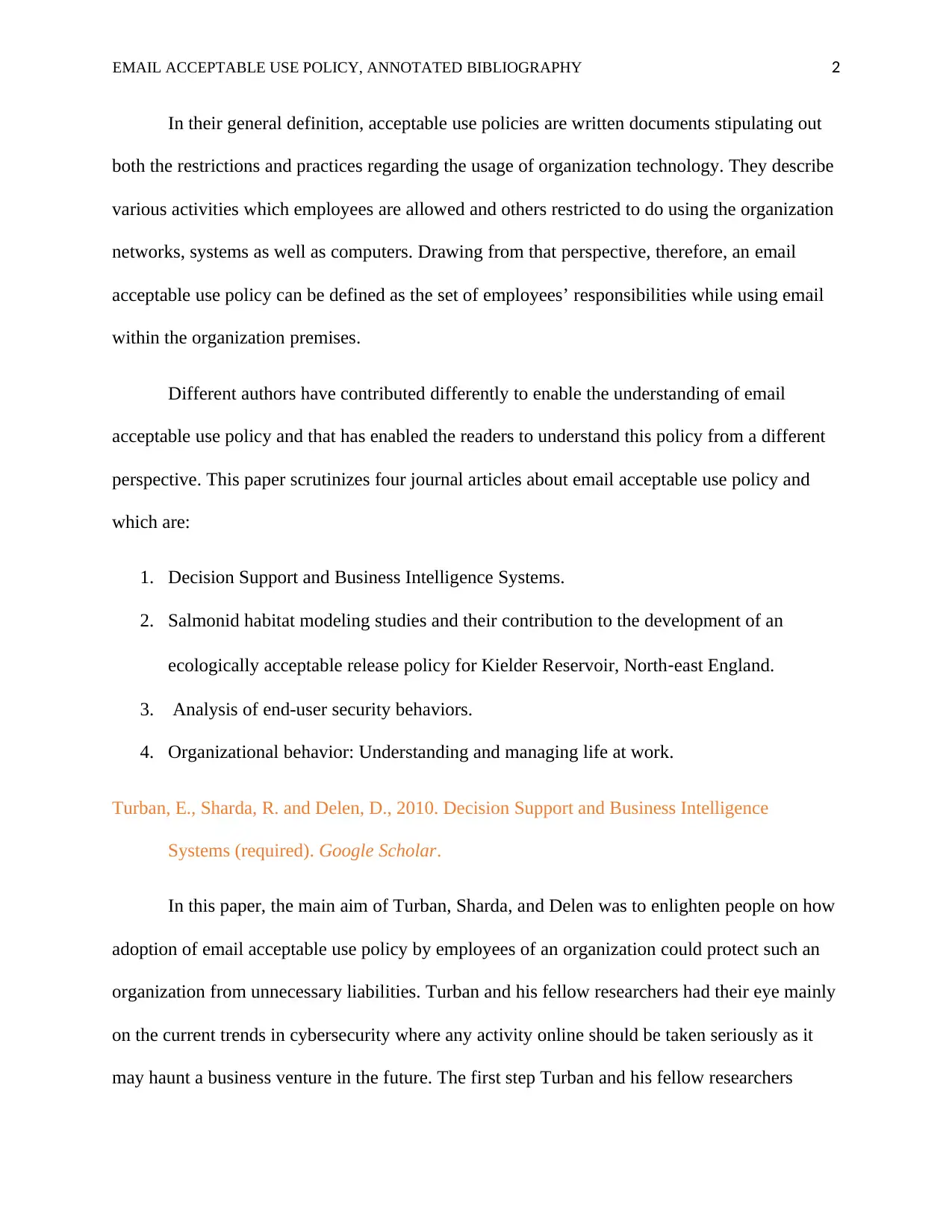
EMAIL ACCEPTABLE USE POLICY, ANNOTATED BIBLIOGRAPHY 2
In their general definition, acceptable use policies are written documents stipulating out
both the restrictions and practices regarding the usage of organization technology. They describe
various activities which employees are allowed and others restricted to do using the organization
networks, systems as well as computers. Drawing from that perspective, therefore, an email
acceptable use policy can be defined as the set of employees’ responsibilities while using email
within the organization premises.
Different authors have contributed differently to enable the understanding of email
acceptable use policy and that has enabled the readers to understand this policy from a different
perspective. This paper scrutinizes four journal articles about email acceptable use policy and
which are:
1. Decision Support and Business Intelligence Systems.
2. Salmonid habitat modeling studies and their contribution to the development of an
ecologically acceptable release policy for Kielder Reservoir, North‐east England.
3. Analysis of end-user security behaviors.
4. Organizational behavior: Understanding and managing life at work.
Turban, E., Sharda, R. and Delen, D., 2010. Decision Support and Business Intelligence
Systems (required). Google Scholar.
In this paper, the main aim of Turban, Sharda, and Delen was to enlighten people on how
adoption of email acceptable use policy by employees of an organization could protect such an
organization from unnecessary liabilities. Turban and his fellow researchers had their eye mainly
on the current trends in cybersecurity where any activity online should be taken seriously as it
may haunt a business venture in the future. The first step Turban and his fellow researchers
In their general definition, acceptable use policies are written documents stipulating out
both the restrictions and practices regarding the usage of organization technology. They describe
various activities which employees are allowed and others restricted to do using the organization
networks, systems as well as computers. Drawing from that perspective, therefore, an email
acceptable use policy can be defined as the set of employees’ responsibilities while using email
within the organization premises.
Different authors have contributed differently to enable the understanding of email
acceptable use policy and that has enabled the readers to understand this policy from a different
perspective. This paper scrutinizes four journal articles about email acceptable use policy and
which are:
1. Decision Support and Business Intelligence Systems.
2. Salmonid habitat modeling studies and their contribution to the development of an
ecologically acceptable release policy for Kielder Reservoir, North‐east England.
3. Analysis of end-user security behaviors.
4. Organizational behavior: Understanding and managing life at work.
Turban, E., Sharda, R. and Delen, D., 2010. Decision Support and Business Intelligence
Systems (required). Google Scholar.
In this paper, the main aim of Turban, Sharda, and Delen was to enlighten people on how
adoption of email acceptable use policy by employees of an organization could protect such an
organization from unnecessary liabilities. Turban and his fellow researchers had their eye mainly
on the current trends in cybersecurity where any activity online should be taken seriously as it
may haunt a business venture in the future. The first step Turban and his fellow researchers
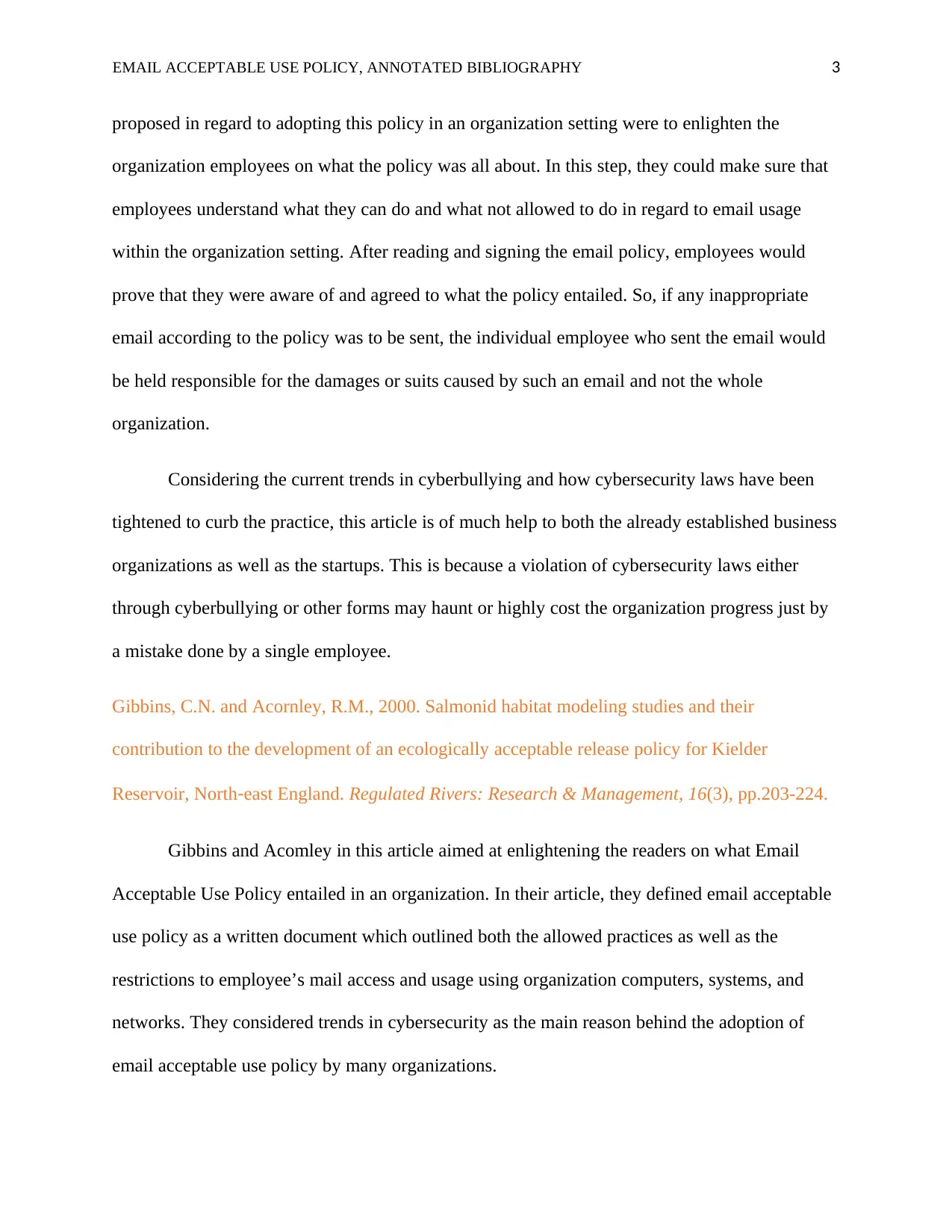
EMAIL ACCEPTABLE USE POLICY, ANNOTATED BIBLIOGRAPHY 3
proposed in regard to adopting this policy in an organization setting were to enlighten the
organization employees on what the policy was all about. In this step, they could make sure that
employees understand what they can do and what not allowed to do in regard to email usage
within the organization setting. After reading and signing the email policy, employees would
prove that they were aware of and agreed to what the policy entailed. So, if any inappropriate
email according to the policy was to be sent, the individual employee who sent the email would
be held responsible for the damages or suits caused by such an email and not the whole
organization.
Considering the current trends in cyberbullying and how cybersecurity laws have been
tightened to curb the practice, this article is of much help to both the already established business
organizations as well as the startups. This is because a violation of cybersecurity laws either
through cyberbullying or other forms may haunt or highly cost the organization progress just by
a mistake done by a single employee.
Gibbins, C.N. and Acornley, R.M., 2000. Salmonid habitat modeling studies and their
contribution to the development of an ecologically acceptable release policy for Kielder
Reservoir, North‐east England. Regulated Rivers: Research & Management, 16(3), pp.203-224.
Gibbins and Acomley in this article aimed at enlightening the readers on what Email
Acceptable Use Policy entailed in an organization. In their article, they defined email acceptable
use policy as a written document which outlined both the allowed practices as well as the
restrictions to employee’s mail access and usage using organization computers, systems, and
networks. They considered trends in cybersecurity as the main reason behind the adoption of
email acceptable use policy by many organizations.
proposed in regard to adopting this policy in an organization setting were to enlighten the
organization employees on what the policy was all about. In this step, they could make sure that
employees understand what they can do and what not allowed to do in regard to email usage
within the organization setting. After reading and signing the email policy, employees would
prove that they were aware of and agreed to what the policy entailed. So, if any inappropriate
email according to the policy was to be sent, the individual employee who sent the email would
be held responsible for the damages or suits caused by such an email and not the whole
organization.
Considering the current trends in cyberbullying and how cybersecurity laws have been
tightened to curb the practice, this article is of much help to both the already established business
organizations as well as the startups. This is because a violation of cybersecurity laws either
through cyberbullying or other forms may haunt or highly cost the organization progress just by
a mistake done by a single employee.
Gibbins, C.N. and Acornley, R.M., 2000. Salmonid habitat modeling studies and their
contribution to the development of an ecologically acceptable release policy for Kielder
Reservoir, North‐east England. Regulated Rivers: Research & Management, 16(3), pp.203-224.
Gibbins and Acomley in this article aimed at enlightening the readers on what Email
Acceptable Use Policy entailed in an organization. In their article, they defined email acceptable
use policy as a written document which outlined both the allowed practices as well as the
restrictions to employee’s mail access and usage using organization computers, systems, and
networks. They considered trends in cybersecurity as the main reason behind the adoption of
email acceptable use policy by many organizations.
⊘ This is a preview!⊘
Do you want full access?
Subscribe today to unlock all pages.

Trusted by 1+ million students worldwide
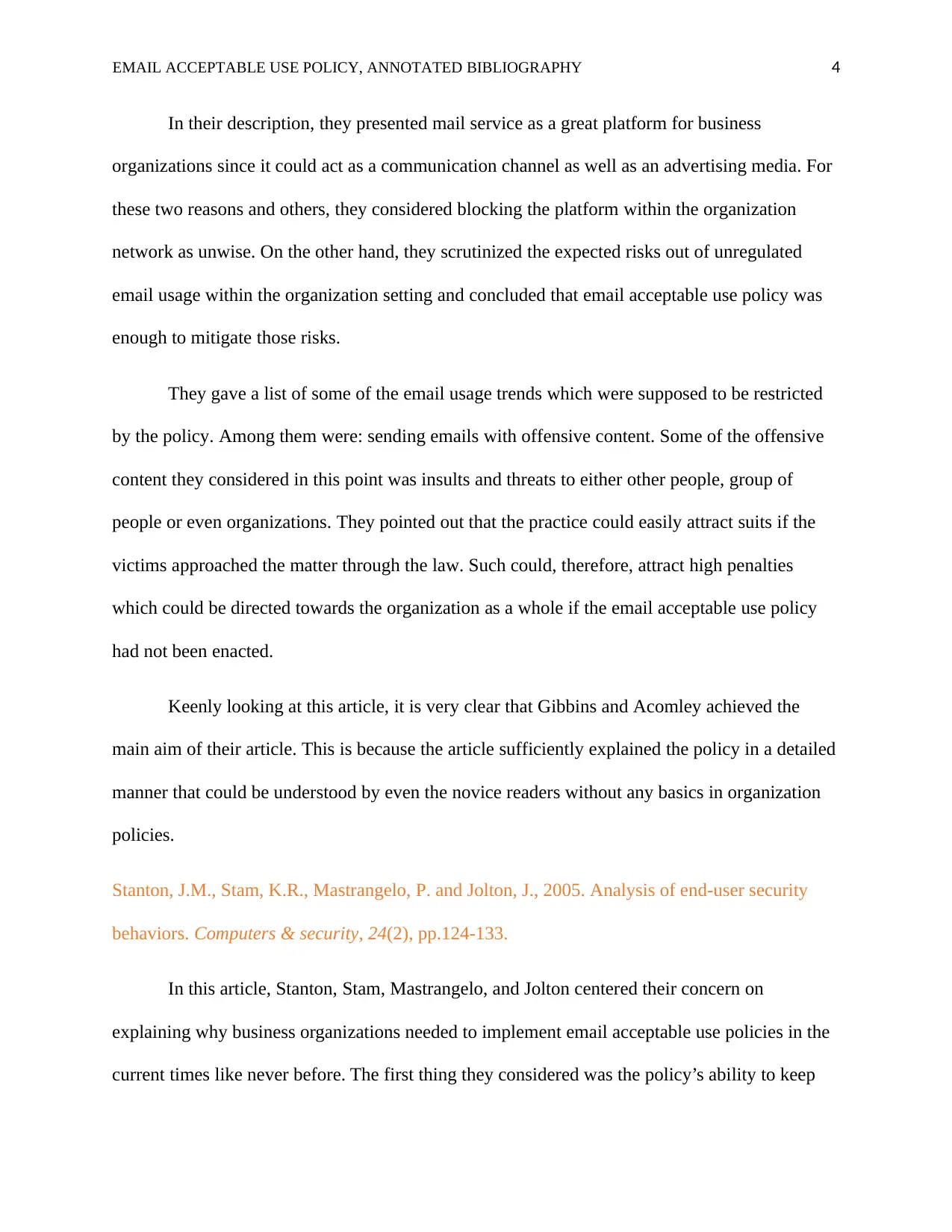
EMAIL ACCEPTABLE USE POLICY, ANNOTATED BIBLIOGRAPHY 4
In their description, they presented mail service as a great platform for business
organizations since it could act as a communication channel as well as an advertising media. For
these two reasons and others, they considered blocking the platform within the organization
network as unwise. On the other hand, they scrutinized the expected risks out of unregulated
email usage within the organization setting and concluded that email acceptable use policy was
enough to mitigate those risks.
They gave a list of some of the email usage trends which were supposed to be restricted
by the policy. Among them were: sending emails with offensive content. Some of the offensive
content they considered in this point was insults and threats to either other people, group of
people or even organizations. They pointed out that the practice could easily attract suits if the
victims approached the matter through the law. Such could, therefore, attract high penalties
which could be directed towards the organization as a whole if the email acceptable use policy
had not been enacted.
Keenly looking at this article, it is very clear that Gibbins and Acomley achieved the
main aim of their article. This is because the article sufficiently explained the policy in a detailed
manner that could be understood by even the novice readers without any basics in organization
policies.
Stanton, J.M., Stam, K.R., Mastrangelo, P. and Jolton, J., 2005. Analysis of end-user security
behaviors. Computers & security, 24(2), pp.124-133.
In this article, Stanton, Stam, Mastrangelo, and Jolton centered their concern on
explaining why business organizations needed to implement email acceptable use policies in the
current times like never before. The first thing they considered was the policy’s ability to keep
In their description, they presented mail service as a great platform for business
organizations since it could act as a communication channel as well as an advertising media. For
these two reasons and others, they considered blocking the platform within the organization
network as unwise. On the other hand, they scrutinized the expected risks out of unregulated
email usage within the organization setting and concluded that email acceptable use policy was
enough to mitigate those risks.
They gave a list of some of the email usage trends which were supposed to be restricted
by the policy. Among them were: sending emails with offensive content. Some of the offensive
content they considered in this point was insults and threats to either other people, group of
people or even organizations. They pointed out that the practice could easily attract suits if the
victims approached the matter through the law. Such could, therefore, attract high penalties
which could be directed towards the organization as a whole if the email acceptable use policy
had not been enacted.
Keenly looking at this article, it is very clear that Gibbins and Acomley achieved the
main aim of their article. This is because the article sufficiently explained the policy in a detailed
manner that could be understood by even the novice readers without any basics in organization
policies.
Stanton, J.M., Stam, K.R., Mastrangelo, P. and Jolton, J., 2005. Analysis of end-user security
behaviors. Computers & security, 24(2), pp.124-133.
In this article, Stanton, Stam, Mastrangelo, and Jolton centered their concern on
explaining why business organizations needed to implement email acceptable use policies in the
current times like never before. The first thing they considered was the policy’s ability to keep
Paraphrase This Document
Need a fresh take? Get an instant paraphrase of this document with our AI Paraphraser
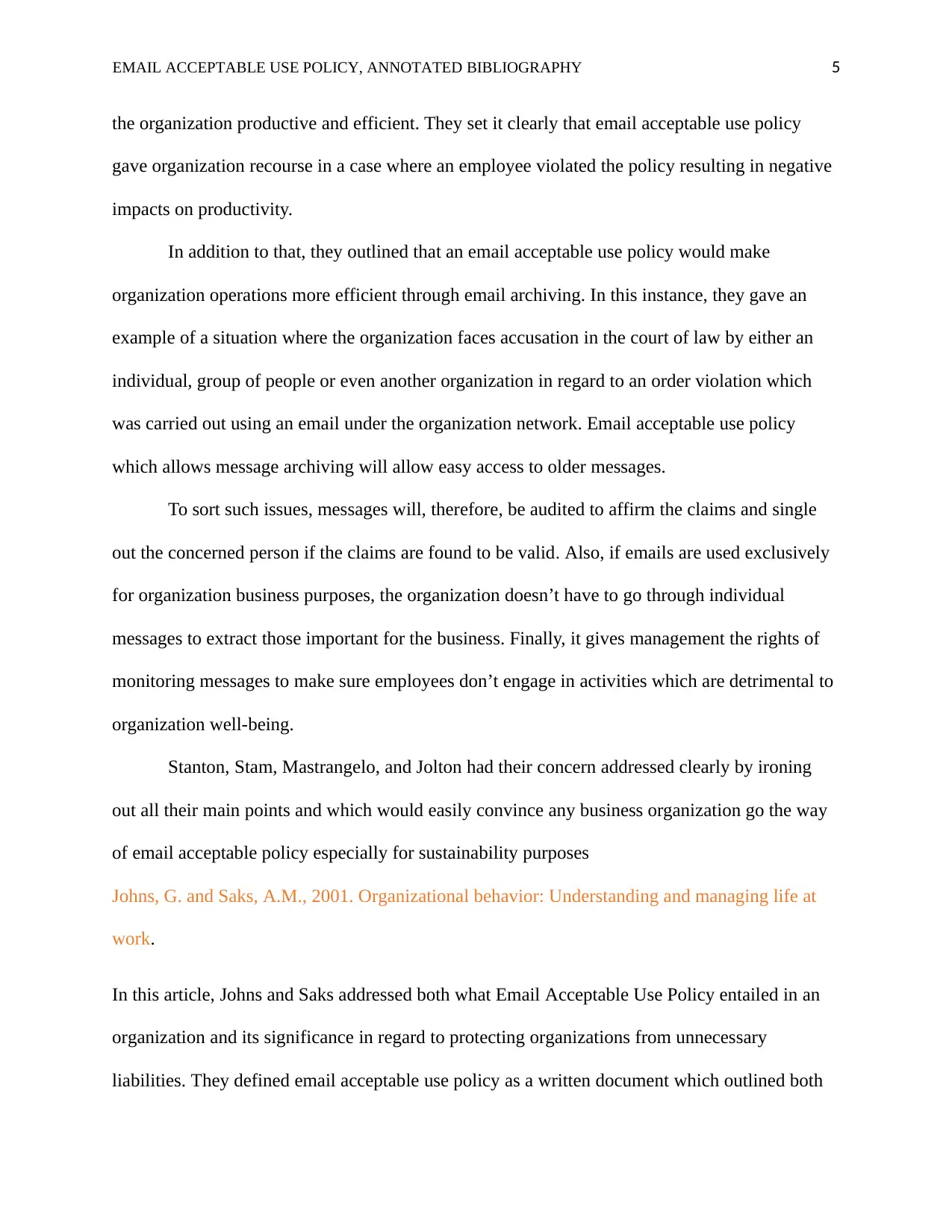
EMAIL ACCEPTABLE USE POLICY, ANNOTATED BIBLIOGRAPHY 5
the organization productive and efficient. They set it clearly that email acceptable use policy
gave organization recourse in a case where an employee violated the policy resulting in negative
impacts on productivity.
In addition to that, they outlined that an email acceptable use policy would make
organization operations more efficient through email archiving. In this instance, they gave an
example of a situation where the organization faces accusation in the court of law by either an
individual, group of people or even another organization in regard to an order violation which
was carried out using an email under the organization network. Email acceptable use policy
which allows message archiving will allow easy access to older messages.
To sort such issues, messages will, therefore, be audited to affirm the claims and single
out the concerned person if the claims are found to be valid. Also, if emails are used exclusively
for organization business purposes, the organization doesn’t have to go through individual
messages to extract those important for the business. Finally, it gives management the rights of
monitoring messages to make sure employees don’t engage in activities which are detrimental to
organization well-being.
Stanton, Stam, Mastrangelo, and Jolton had their concern addressed clearly by ironing
out all their main points and which would easily convince any business organization go the way
of email acceptable policy especially for sustainability purposes
Johns, G. and Saks, A.M., 2001. Organizational behavior: Understanding and managing life at
work.
In this article, Johns and Saks addressed both what Email Acceptable Use Policy entailed in an
organization and its significance in regard to protecting organizations from unnecessary
liabilities. They defined email acceptable use policy as a written document which outlined both
the organization productive and efficient. They set it clearly that email acceptable use policy
gave organization recourse in a case where an employee violated the policy resulting in negative
impacts on productivity.
In addition to that, they outlined that an email acceptable use policy would make
organization operations more efficient through email archiving. In this instance, they gave an
example of a situation where the organization faces accusation in the court of law by either an
individual, group of people or even another organization in regard to an order violation which
was carried out using an email under the organization network. Email acceptable use policy
which allows message archiving will allow easy access to older messages.
To sort such issues, messages will, therefore, be audited to affirm the claims and single
out the concerned person if the claims are found to be valid. Also, if emails are used exclusively
for organization business purposes, the organization doesn’t have to go through individual
messages to extract those important for the business. Finally, it gives management the rights of
monitoring messages to make sure employees don’t engage in activities which are detrimental to
organization well-being.
Stanton, Stam, Mastrangelo, and Jolton had their concern addressed clearly by ironing
out all their main points and which would easily convince any business organization go the way
of email acceptable policy especially for sustainability purposes
Johns, G. and Saks, A.M., 2001. Organizational behavior: Understanding and managing life at
work.
In this article, Johns and Saks addressed both what Email Acceptable Use Policy entailed in an
organization and its significance in regard to protecting organizations from unnecessary
liabilities. They defined email acceptable use policy as a written document which outlined both
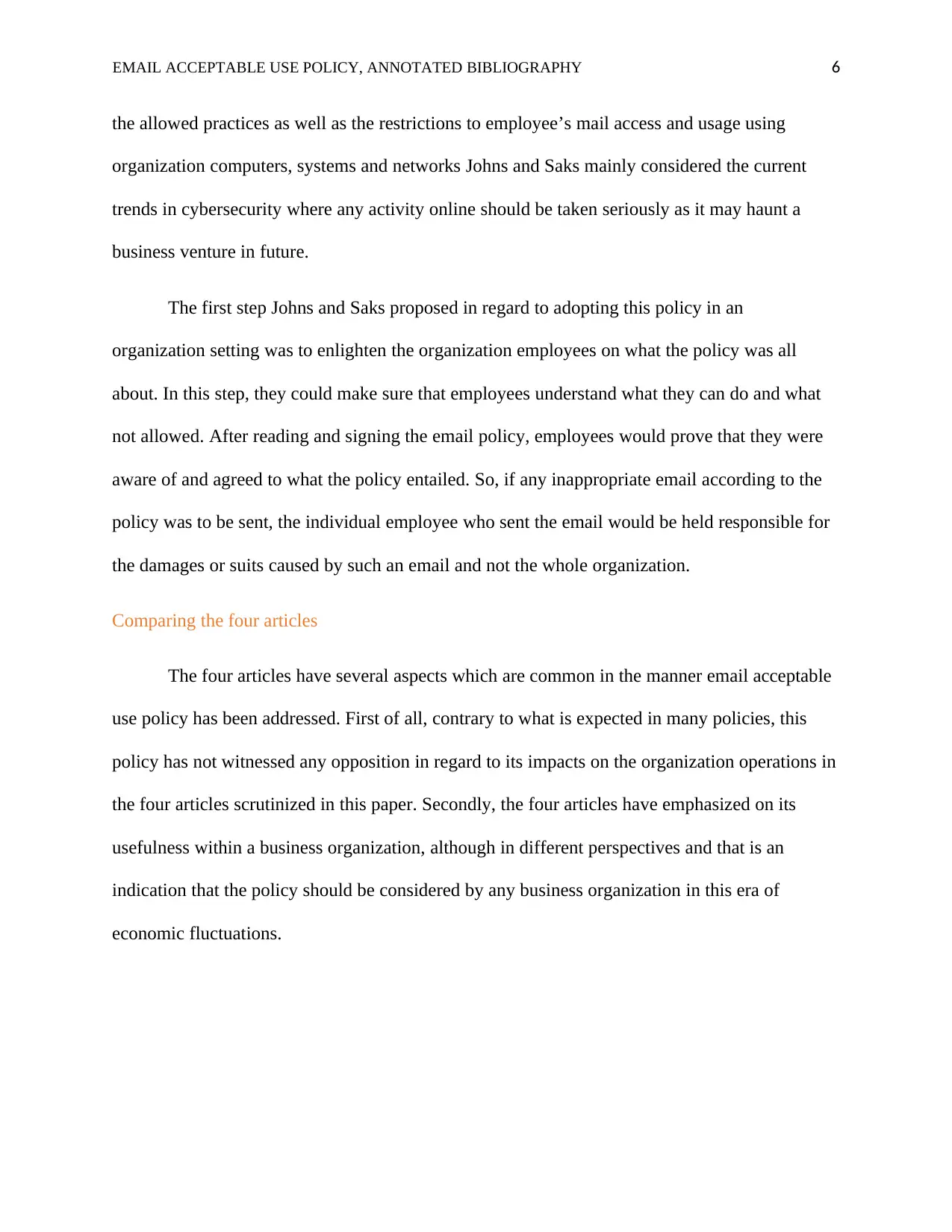
EMAIL ACCEPTABLE USE POLICY, ANNOTATED BIBLIOGRAPHY 6
the allowed practices as well as the restrictions to employee’s mail access and usage using
organization computers, systems and networks Johns and Saks mainly considered the current
trends in cybersecurity where any activity online should be taken seriously as it may haunt a
business venture in future.
The first step Johns and Saks proposed in regard to adopting this policy in an
organization setting was to enlighten the organization employees on what the policy was all
about. In this step, they could make sure that employees understand what they can do and what
not allowed. After reading and signing the email policy, employees would prove that they were
aware of and agreed to what the policy entailed. So, if any inappropriate email according to the
policy was to be sent, the individual employee who sent the email would be held responsible for
the damages or suits caused by such an email and not the whole organization.
Comparing the four articles
The four articles have several aspects which are common in the manner email acceptable
use policy has been addressed. First of all, contrary to what is expected in many policies, this
policy has not witnessed any opposition in regard to its impacts on the organization operations in
the four articles scrutinized in this paper. Secondly, the four articles have emphasized on its
usefulness within a business organization, although in different perspectives and that is an
indication that the policy should be considered by any business organization in this era of
economic fluctuations.
the allowed practices as well as the restrictions to employee’s mail access and usage using
organization computers, systems and networks Johns and Saks mainly considered the current
trends in cybersecurity where any activity online should be taken seriously as it may haunt a
business venture in future.
The first step Johns and Saks proposed in regard to adopting this policy in an
organization setting was to enlighten the organization employees on what the policy was all
about. In this step, they could make sure that employees understand what they can do and what
not allowed. After reading and signing the email policy, employees would prove that they were
aware of and agreed to what the policy entailed. So, if any inappropriate email according to the
policy was to be sent, the individual employee who sent the email would be held responsible for
the damages or suits caused by such an email and not the whole organization.
Comparing the four articles
The four articles have several aspects which are common in the manner email acceptable
use policy has been addressed. First of all, contrary to what is expected in many policies, this
policy has not witnessed any opposition in regard to its impacts on the organization operations in
the four articles scrutinized in this paper. Secondly, the four articles have emphasized on its
usefulness within a business organization, although in different perspectives and that is an
indication that the policy should be considered by any business organization in this era of
economic fluctuations.
⊘ This is a preview!⊘
Do you want full access?
Subscribe today to unlock all pages.

Trusted by 1+ million students worldwide
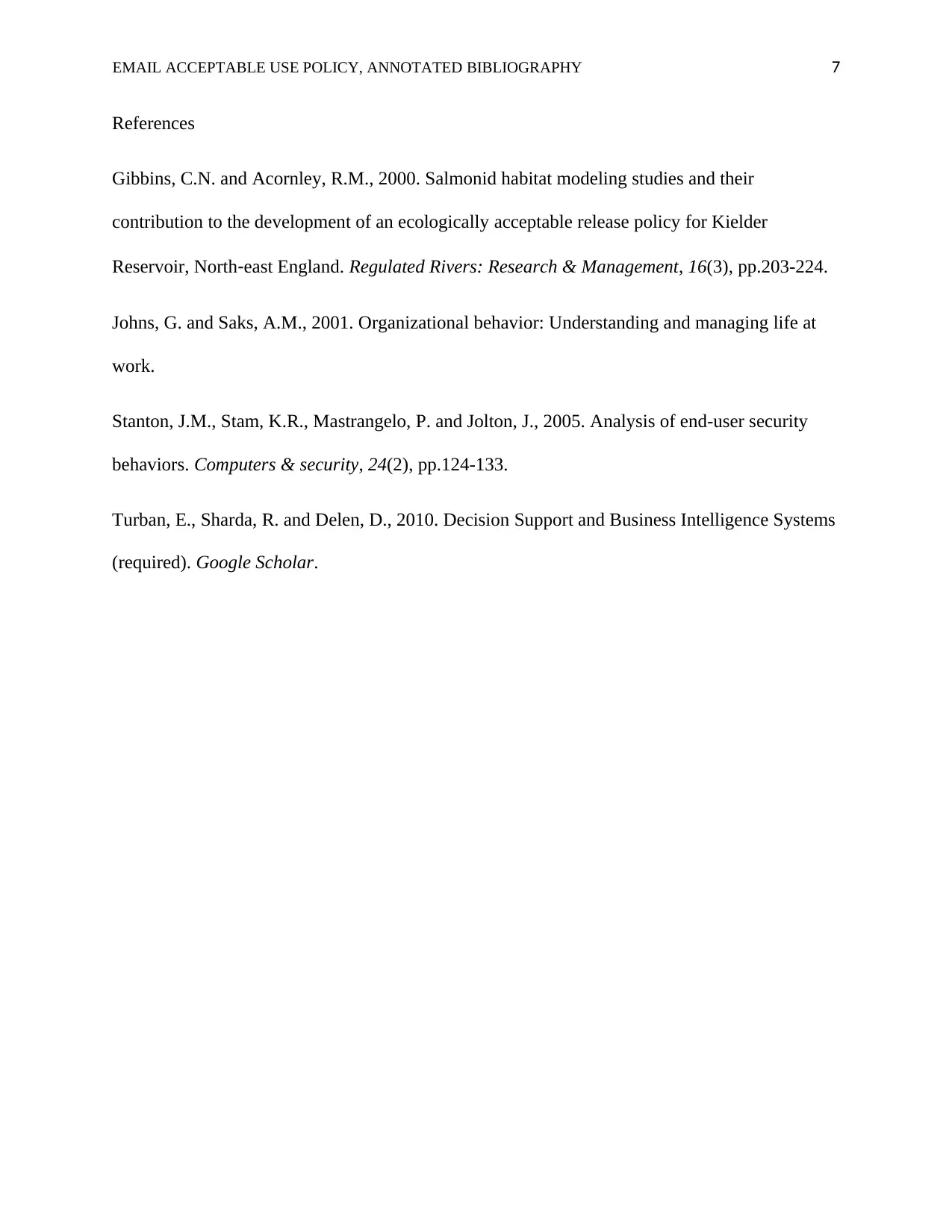
EMAIL ACCEPTABLE USE POLICY, ANNOTATED BIBLIOGRAPHY 7
References
Gibbins, C.N. and Acornley, R.M., 2000. Salmonid habitat modeling studies and their
contribution to the development of an ecologically acceptable release policy for Kielder
Reservoir, North‐east England. Regulated Rivers: Research & Management, 16(3), pp.203-224.
Johns, G. and Saks, A.M., 2001. Organizational behavior: Understanding and managing life at
work.
Stanton, J.M., Stam, K.R., Mastrangelo, P. and Jolton, J., 2005. Analysis of end-user security
behaviors. Computers & security, 24(2), pp.124-133.
Turban, E., Sharda, R. and Delen, D., 2010. Decision Support and Business Intelligence Systems
(required). Google Scholar.
References
Gibbins, C.N. and Acornley, R.M., 2000. Salmonid habitat modeling studies and their
contribution to the development of an ecologically acceptable release policy for Kielder
Reservoir, North‐east England. Regulated Rivers: Research & Management, 16(3), pp.203-224.
Johns, G. and Saks, A.M., 2001. Organizational behavior: Understanding and managing life at
work.
Stanton, J.M., Stam, K.R., Mastrangelo, P. and Jolton, J., 2005. Analysis of end-user security
behaviors. Computers & security, 24(2), pp.124-133.
Turban, E., Sharda, R. and Delen, D., 2010. Decision Support and Business Intelligence Systems
(required). Google Scholar.
1 out of 7
Your All-in-One AI-Powered Toolkit for Academic Success.
+13062052269
info@desklib.com
Available 24*7 on WhatsApp / Email
![[object Object]](/_next/static/media/star-bottom.7253800d.svg)
Unlock your academic potential
Copyright © 2020–2025 A2Z Services. All Rights Reserved. Developed and managed by ZUCOL.